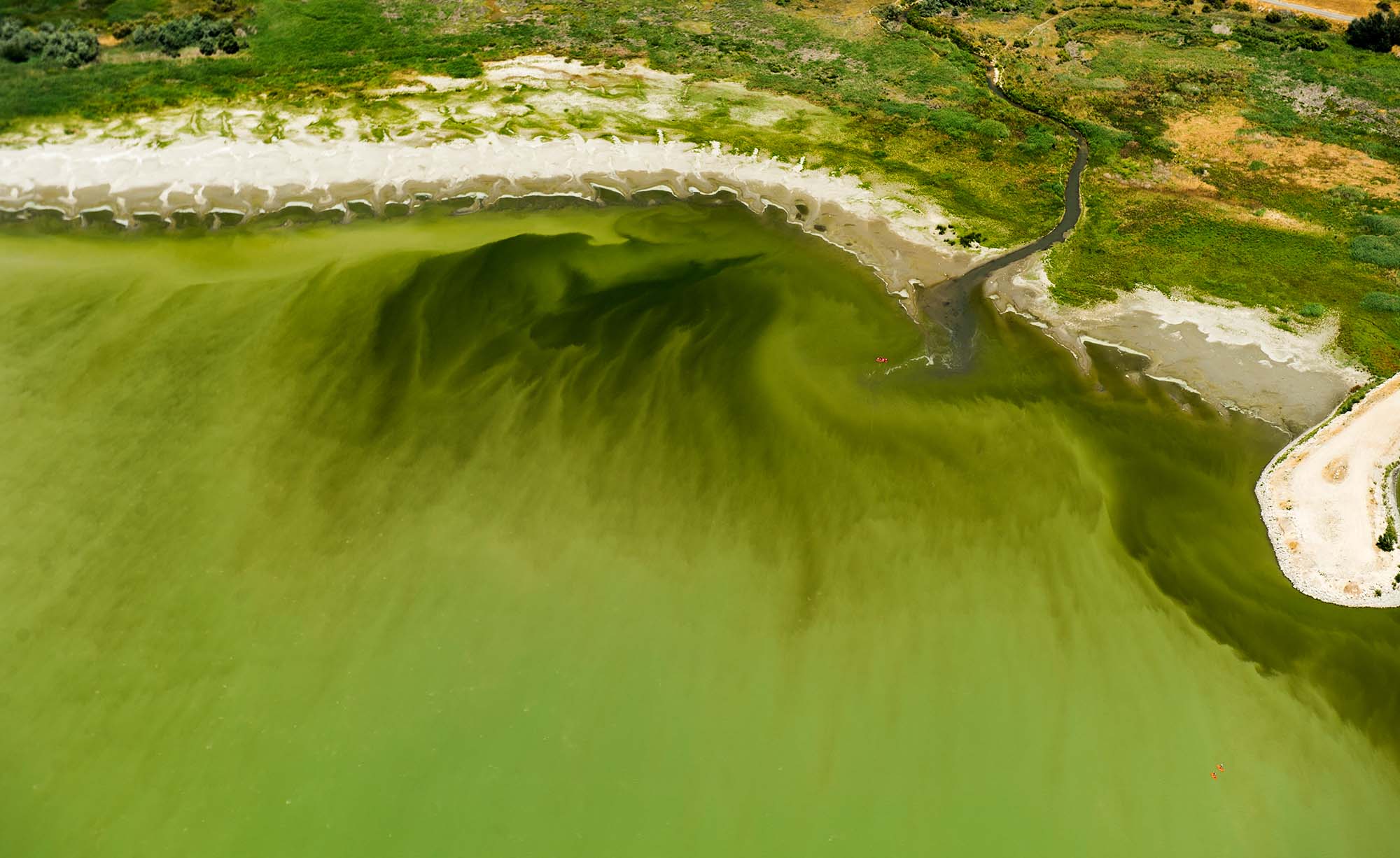Story by Emma Penrod; photos by Francisco Kjolseth, Al Hartmann and Rick Egan
Feedback: epenrod@sltrib.com, @EmaPen
Part 1: What’s causing Utah Lake’s massive algae problem?
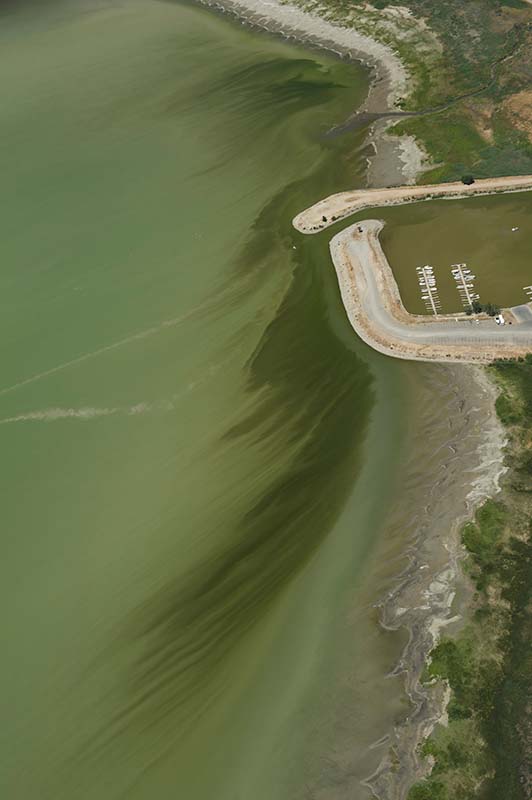
Utah Lake on July 14, 2015
Rick Egan/The Salt Lake Tribune
By the time Walt Baker, director of the state Division of Water Quality, got the July 14 call about algae in Utah Lake, the bloom already had been visible from overhead satellites for at least three days.
The next day, test results indicating high concentrations of potentially toxic cyanobacteria prompted the Utah County Health Department to order the lake’s closure. By July 17, warning signs dotted some 40 miles of the Jordan River’s path through Utah and Salt Lake counties, and residual effects remain more than a month later.
It was, according to state officials, the largest documented algal bloom in Utah history. Yet its appearance did not come as a surprise to those familiar with the Utah Lake system, which has been used to dispose of some of civilization’s least-desirable byproducts for decades.
The state holds that cleaning up this waste is the path of least resistance if Utah wants to stop the algae problem from worsening. Other experts are less convinced, pointing to theories that suggest the problems on Utah Lake, the Jordan River and the Great Salt Lake are far more complicated — even an effect of global warming.
And the state’s latest efforts to verify whether its solution will work, some say, may do little more than muddy the waters.
How to bake an algal bloom
There is a recipe that leads to the growth of an algal bloom, said Paul “Skip” Price, an assistant research professor at Brigham Young University who has built a base of knowledge about algal blooms while studying nitrogen fertilization.
Cyanobacteria, species of bacteria generally called blue-green algae because they behave like their forest-green neighbors, are naturally present in most bodies of water. When water is warm and stagnant, and sunlight and nutrients are abundant, the potentially toxic species will begin to multiply much more rapidly than usual.
Some algal blooms occur naturally — there are fossil records, Price said, that indicate algal blooms occurred periodically in the western U.S. long before humans arrived on the scene.
LaVere Merritt, a professor emeritus who studied algal blooms — and specifically algal blooms on Utah Lake — on and off during his 40-year career at BYU, said lakes at the bottom of a valley tend to accumulate a lot of naturally nutrient-rich debris, like leaf litter. If such lakes are also shallow and located in warm climates, they may periodically experience algal blooms without much human interaction.
Utah Lake matches that profile — plus it has been the recipient of decades of sewage.
Utah’s early cities were built with rudimentary systems that conveyed sewage to the nearest river for disposal; Utah had no wastewater treatment plants before the 1940s, according to a short history written by Calvin Sudweeks, a longtime water-quality manager for the state.
On the Wasatch Front, Baker said, that made Utah Lake and the Jordan River the endpoint for many pioneering wastewater systems. Utah Lake water flows via the Jordan River into the Great Salt Lake, which has no natural outlet beside evaporation — making it the final resting place for much of the surrounding area’s waste, including sewage.
Today, about 71 percent of Utah’s effluent — treated sewage — ultimately ends up in the Great Salt Lake. Upstream, about 13.5 percent of the water in Utah Lake comes from wastewater treatment plants, according to the latest count in 2010.
The current projection — assuming all other factors remain constant — is that as Utah County continues to grow, effluent discharge will account for more than a quarter of all the water flowing into Utah Lake by 2050, Baker said.
He believes addressing this trend is the first step to limiting algal growth on Utah Lake.
“Something needs to be done,” he said. “In our belief, that something is to stem the source of food for the algae and remove nutrients from Utah Lake to a greater degree.”
State and federal regulations prohibit discharge of untreated sewage — but there are no federal limits on the nutrient content of effluent. The Environmental Protection Agency has declined to pass such rules, instead indicating that the states should develop site-specific standards.
“Some states have done that with more urgency than other states,” Baker said. “Larger states have more resources; some small states haven’t done anything.”
Utah has been working to develop nutrient standards for the past six years. The first of those standards, which will apply to key headwaters and streams that feed into Utah’s larger waterways, should be unveiled next spring, Baker said.
But standards for Utah Lake, the Jordan River and the Great Salt Lake are still a ways off. Baker said he doesn’t expect to see a site-specific standard for Utah Lake before a $1 million study of Utah Lake — which obtained funding in late August — is complete in 2020. The Jordan River and the Great Salt Lake aren’t considered priorities for standards development; waters that provide drinking water take precedence.
The state does have a technology-based limit related to phosphorus, which requires wastewater-treatment plants to install technologies that remove phosphorus by 2020. That requirement should cut the amount of phosphorus discharged from wastewater0treatment plants into Utah waters by two-thirds, Baker said.
But some aren’t convinced nutrient limits are the best means to control algae in Utah Lake.
Climate change at play
To get to the point of starving the algae into submission, Merritt believes Utah would have to prevent about 95 percent of the phosphorus currently flowing into Utah Lake — from all sources, not just wastewater — from getting there. And that, he said, would be effectively impossible.
Utah Lake contains a natural nutrient load large enough to support massive algal blooms all the time, and yet these blooms don’t have a constant presence in the lake — leading Merritt to believe something else is setting them off.
Merritt said toxic algal blooms occur on Utah Lake every couple of years, following a sequence of events kicked off by low lake levels.
In July, the drainage basin that encircles the Great Salt Lake, the Jordan River and Utah Lake received 18 percent of the rainfall it typically gets that month. As of late August, Utah Lake had shrunk to 37 percent of its capacity, according to the Central Utah Water Conservancy District, leaving the lake with an average depth of about 2.5 feet.
If the lake is shallow enough when Utah experiences an extended period of hot, dry weather, Merritt said, the calm conditions not only heat up the lake, but also allow sediment that is usually suspended in the water to sink to the bottom. This lets sunlight penetrate deeper into the lake, triggering the beginnings of an algal bloom.
These days, the weather isn’t exactly doing what it used to, Price said.
“In my mind, as a scientist, the evidence is very clear that climate change is occurring,” he said, “and that the stabilized high temperatures in the region could be an effect of climate change.”
Generally, Baker said, it takes a whole summer’s worth of hot weather to heat up a lake to the point where an algal bloom can occur. He would expect algal blooms to occur in September or early October — not July.
According to the National Weather Service, the month preceding the Utah Lake algal bloom was the hottest June that Utahns have ever seen. July, by month’s end, was the fourth-hottest.
So were humans responsible for July’s algal bloom — or was it all part of a natural phenomenon?
Price said his jury is still out, though he believes humans, and locals in particular, probably did play a role. Merritt thinks probably not, though he says that doesn’t mean humans haven’t caused trouble for the lake.
In Baker’s mind, there’s no doubt. And it’s not just one or two people at fault, he says — it’s all of us.
“This is not mother nature doing what mother nature does,” he said. “There have been blooms before. But what we are seeing is unprecedented. … It could be the new normal, but from my point of view, this is a problem that we need to collectively own up to.”

Discolored water in Utah Lake, looking south from Lindon Marina on July 14, 2016.
Rick Egan/The Salt Lake Tribune
Will funding dry up?
Another difficulty facing Utah Lake is the dearth of scientific research on the system.
Utah Lake was the subject of a great deal of scientific inquiry in the early 2000s, Baker said, when monitors detected elevated levels of phosphorus, salts and a specific pollutant: an organic chlorine compound known as PCB. The state considered establishing a Total Maximum Daily Load (TMDL), which would place limits on how much of a certain pollutant is allowable within a given waterway and would identify required reductions from nearby sources.
But over time, the salts were discovered to be natural and the PCB went away on its own, leaving only the elevated phosphorus levels.
In 2007, Baker said, the Division of Water Quality decided to put the TMDL development on hold to allow other state agencies to deal with invasive species in the lake.
This pattern of events has been an ongoing problem for the lake, Merritt said. Research projects start, then grind to a halt, amounting to little more than short-term data collecting that fails to illuminate the root of Utah Lake’s long-term problems.
Merritt fears that will be true of the state’s current million-dollar initiative. He expects this effort, like so many others, will result in “a peak of interest and then a valley of nothing.”
Leland Myers, who has researched algal blooms in Farmington Bay on the Great Salt Lake while managing the Central Davis Sewer District, said if the state wants to understand Utah Lake, it needs to invest $5 million. Maybe $10 million.
This “$1 million will help you,” he said, “but it won’t get you there.”
This kind of funding is unheard of in Baker’s world, where the budget for ongoing operations related to algal blooms — excepting various grants and one-time appropriations — is currently zero.
It’s not that the Division of Water Quality is underfunded, Baker said. Between state and federal funds, the division has a $10.8 million operating budget. But a lot of that money already is tied up with other designated purposes, Baker said, and the division can’t deploy secretaries and accountants to collect algae samples.
During the past two years, Baker said, he has tried unsuccessfully to procure funding from the Legislature for equipment that would be capable of providing the division with a 24-7 stream of data about various conditions in Utah Lake.
He’s more optimistic about his request this year, given recent events, and plans to approach state leaders to ask for an ongoing algal bloom response fund of about $55,000 a year.
With the going rate for responding to an algal bloom sitting at $26,000 a week, Baker said, that should get the division through two moderate-sized blooms a year.
It wouldn’t cover a bloom the size of this July’s, though. Baker said the lab work alone for the Utah Lake bloom cost the division $77,000 over two weeks. That doesn’t include the cost of equipment, staffing or those costs assumed by local health departments when the Division of Water Quality decided to, as a rule of thumb, turn over ongoing sampling and response efforts to the appropriate health department after six initial samples.
“This is a cost we haven’t budgeted for,” Baker said, “and it’s frankly unsustainable for us to keep that up for three, four of the warmest months of the year.”




Getting the science right
In the absence of scientific knowledge, Merritt said, politics has stepped in to fill the void. People on all sides of the issue have through the years become increasingly entrenched in their positions and less willing to consider alternative points of view.
“I frankly think the whole thing needs a very careful, blue-ribbon review,” he said, “that gets outside the personalities and players and tries to get back to where we have agreement rather than controversy.”
After that, he said, he’d like to see someone establish a quasi-independent research station on Utah Lake with dedicated funding for long-term study.
Trying to manage the lake without adequate knowledge of its ecosystem won’t work, Merritt said. So until more conclusive information is available from such a center, he said “environmental tidiness, not thinking of it as a place to throw our garbage,” is probably the best thing locals could do to preserve the lake.
He worries a knee-jerk reaction could result in short bursts of funding for less-thorough studies intended to shut down opposing views.
The $1 million “will not greatly advance our understanding of the lake,” he said. “It could help, but if we’re there to prove something, it won’t go to true assessment or true understanding of the ecology of the lake.”
Provo’s deputy mayor, Corey Norman, is also wary of recommendations coming from the state.
“We all want the lake to be healthy,” he said, “but we also don’t want to spend millions of dollars on something that might not work.”
The Provo City Council recently passed a resolution intended, Norman said, to encourage the Division of Water Quality to pursue additional scientific research and to consider theories outside those of its own staff.
“Some of the facts that the Division of Water Quality is using are facts of convenience,” he said, “where we have just as much information at our fingertips that is inconsistent, or counters what the DWQ says.”
Norman said Provo had “empirical information” that demonstrated limiting the nutrients that go into Utah Lake — the state’s main focus — might not only prove ineffective, but also could harm the lake.
Provo is unable to share or elaborate on its data, he said.
Baker acknowledged that the science indicating the discharge of phosphorus is responsible for the growth of algae on Utah Lake is incomplete. But he argued waiting for final scientific word allows the problem to get worse in the interim.
“I use the term ‘the law of the hole,’ ” he said. “When you find yourself in one, quit digging. We need to stop making the problem worse.”
![]()
Part 2: Is apathy the main ingredient in environmental degradation?
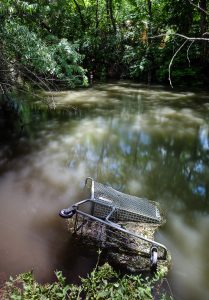
The Jordan River in 2016.
Francisco Kjolseth/The Salt Lake Tribune
Even after living in Utah for nearly four years, Erick Frauedorfer was unaware that Salt Lake City had a river running through it until he was invited to a kayaking trip on the Jordan River.
“It was news to me that it was there,” he said. “I had driven over it on the way to the airport, but honestly I had no idea what it was or where it ran or anything.”
Today, Frauedorfer enjoys paddling down the Jordan River regularly and considers having a river in his backyard to be a tremendous asset. But the community at large, he said, could treat the river with more care.
Recreational access to the Jordan River was restricted this summer when a massive algal bloom in Utah Lake began to spread downstream. While the factors leading up to the bloom are complex and the degree of human responsibility is up for debate, state water managers hope to take advantage of the spike in public interest.
Case studies suggest that when a waterway is highly valued by the surrounding community, the public’s commitment to it can become a source of protection against environmental degradation. But waterways on the Wasatch Front, including the Jordan River, Utah Lake and the Great Salt Lake, haven’t benefited from this effect. Many Utahns have little experience with their backyard water system, and some regard local waterways as worthless, beyond saving, or even dangerous.
Advocates and others who love the waterways believe that if they could get the community to see them the way they do, the political climate would begin to change, and water quality would follow suit.
“When I tell people I work on the Jordan River, people are like, ‘look out for dead bodies,’ ” said Laura Hanson, executive director of the Jordan River Commission. “But it could be so much more than that.”
The Boise effect
For an example of what the Jordan River — or Utah Lake, or even the Great Salt Lake — could be, one should look north to the Boise River, Hanson said.
In the mid-20th century, the Boise River was lined with slaughterhouses and other industry, said Mike Journee, a spokesman for the Boise mayor’s office. People shunned the river, situating homes and businesses to block it from view.
The Boise River still has its problems, but has come a long way from its low point in the 1960s, said Liz Paul, a member of the coordinating team for the Boise River Enhancement Network. Back then, garbage, raw sewage and industrial waste, sometimes whole cars were regularly dumped into the river, and so much water had been diverted from the river that, at times, it was reduced to little more than a dry, rock-lined riverbed.
“It was a gradual kind of awakening people had — that it’s wrong to treat a river that way, and that this could become an asset,” Journee said
Things started to turn around in 1967, he said, when Boise acquired its first land donation to start the greenbelt, which now lines both sides of the river’s 25-mile course through the city. Then came the 1970s and the federal Clean Water Act, which put an end to the discharge of raw waste and trash, Paul said.
Not long after, Paul said, local anglers came together to demand that upstream reservoirs release seasonally appropriate amounts of water to maintain minimum flows in the river and to support a healthy fishery.
That was an important development, Paul said — the increased river flows not only brought in sportsmen looking for a good catch, but also promoted other forms of recreation, such as tubing and kayaking, that have become popular with Boise residents.
“Pretty much everyone who grows up in Boise grows up floating the Boise River,” she said, “so we have three generations now who … have a real recognition that our quality of life is impacted by the Boise River.”
Today, Journee said, the Boise River is one of the mayor’s “three pillars of livability,” alongside the foothills’ trail network and downtown Boise. And last November, 74 percent of Boise residents voted in favor of paying a tax to create a $10 million fund to further preserve open space in and around the city and to support water-quality efforts on the Boise River Corridor.
“It really is part and parcel to the fabric of who we are,” he said. “It’s really something that our city absolutely loves.”

People float the Boise River in June 2015
Courtesy The Idaho Statesman
‘Beneficial use’
The Boise River itself hasn’t experienced algal blooms — the temperature of the water doesn’t support algal growth, Paul said. It is, however, a major contributor of nutrient pollution to the Snake River, which has experienced blooms, she said.
Kate Harris, who coordinates water quality sampling and monitoring in Boise, said a rule limiting the amount of the nutrient phosphorus that may be discharged into the Boise River was put in place last year. Stricter regulations are expected in 2022.
In order to meet those goals, Harris said, local leaders helped to develop a Boise River phosphorus trading agreement. Under that agreement, a wastewater treatment plant that is waiting for upgrades may buy credits from with other plants that surpass the new requirement for phosphorus discharge. Alternatively, plants may help fund the Dixie Drain project, a 49-acre treatment plant on the lower Boise River constructed to remove excess phosphorus.
This idea could hold promise for Utah Lake, said Walt Baker, director of the Utah Division of Water Quality. If downstream facilities agreed to remove unwanted nutrients, upstream facilities could help pay for some of their neighbors’ expenses and avoid their own costly upgrades.
For that matter, Baker said, maybe it’s more effective to re-establish some of the system’s natural swamps and wetlands, which could remove nutrients without the ongoing costs and carbon footprint of a treatment plant.
Restoring waterways’ natural characteristics could help in other ways, too, according to the Friends of the Great Salt Lake.
If the Great Salt Lake had a higher water level, said Lynn de Freitas, the Friends’ executive director, perhaps the lake and the connected systems could offer more recreational opportunities for locals.
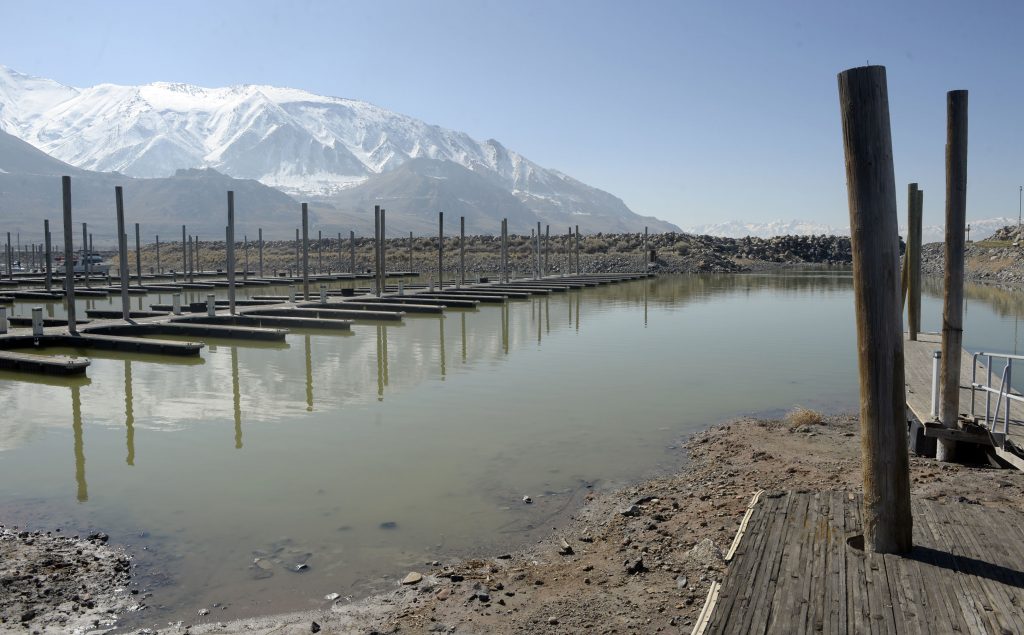
Signs of the Great Salt Lake’s low water level are evident at the Great Salt Lake Marina State Park in February 2016.
Al Hartmann/The Salt Lake Tribune
And as they experienced sailing on the Great Salt Lake, kayaking on the Jordan River or waterskiing on Utah Lake, residents could begin to see these Wasatch Front waterways in the same light that Boise residents view their river.
“I think we have a huge opportunity,” de Freitas said.
The group intends to push the state to designate the Great Salt Lake for “beneficial use,” which would require the state to manage the lake with the feasibility of recreational and industrial uses in mind. That would force the state to leave more water in the Great Salt Lake and in the overall system, de Freitas said.
The group may be on to something, Baker said.
“For too long the Great Salt Lake has not been accorded water,” he said. “It’s just been given whatever is left over after everyone else has had their part, and that’s not a good management strategy.”
‘We don’t have any throwaway waters’
Baker — who’s originally from Boise and is fond of the Boise River — isn’t convinced you can replicate that system’s success in Utah.
The Jordan River and the surrounding systems face challenges Boise never had to deal with, Baker said: More people live along the Wasatch Front than in the Boise metro area. Though the Boise River is the destination for the bulk of that population’s effluent, it still receives wastewater from fewer plants than the Jordan River does. And local waterways have been altered more significantly by human activity than the Boise River ever was.
Plus, the Boise River has always been a cold, fast-moving system, which keeps it mostly clear of algae and refuse.
Consequently, public opinion of the Boise River never saw the depths that many Utahns’ opinions of the Jordan River, Utah Lake, and the Great Salt Lake have sunk to.
And that, Baker said, may be the greatest hurdle local water systems face.
“We can’t treat our waterways as some disposable item, because we’re not making any more water,” he said. “Many would now characterize [this system] as a waste lagoon, and that if we dry it up, that’s no loss. We can’t maintain that thinking. We don’t have any throwaway waters in this state.”
Hanson, taking a page from Boise’s playbook, has an idea for how to go about garnering support for the Jordan River.
There are a lot of people looking for bicycling opportunities or places to kayak, she said, so the commission has focused on creating venues for these experiences.
“Once people get down there, we see a lot of people’s perceptions change,” she said.
But the current condition of Wasatch Front waterways could complicate Hanson’s plan.
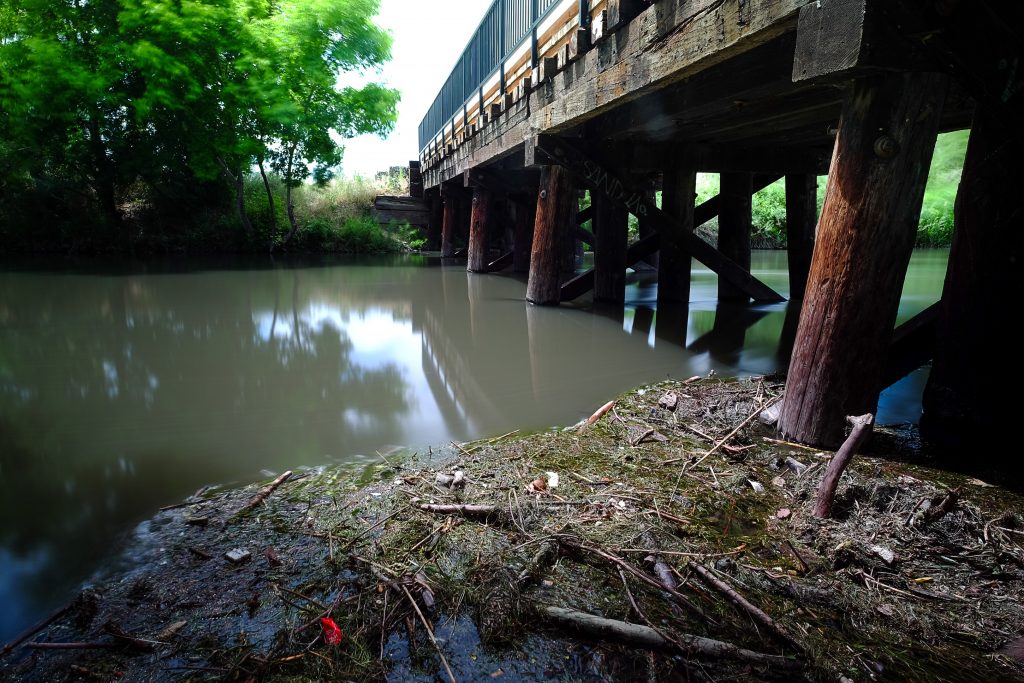
The Jordan River in June 2016
Francisco Kjolseth/The Salt Lake Tribune
Brian Milliner, a West Valley resident, has been kayaking for a decade. The nearby Great Salt Lake, he said, is a great spot for an afternoon with his kayak. But while there’s an access ramp into the Jordan River not too far from his home, he hasn’t been back since he nearly stepped on a pile of used syringes while looking for a place to fish on the riverbank.
Therein lies the conundrum, de Freitas said. The community’s attitude might change, but only if conditions on the water system are conducive to more public access. And those conditions, she said, are a direct result of Utahns’ regard — or lack thereof — for these waterways.
Utah Lake’s toxic algae problem is a “mirror of our activity in the watershed,” she said. “If nothing else, this should be a moment of sober recognition of what we need to do in order to address issues like this now and in the future to protect our water bodies, protect our public health, and continue to strive to achieve a quality of life that we all claim we want.”
Part 3: Collision course
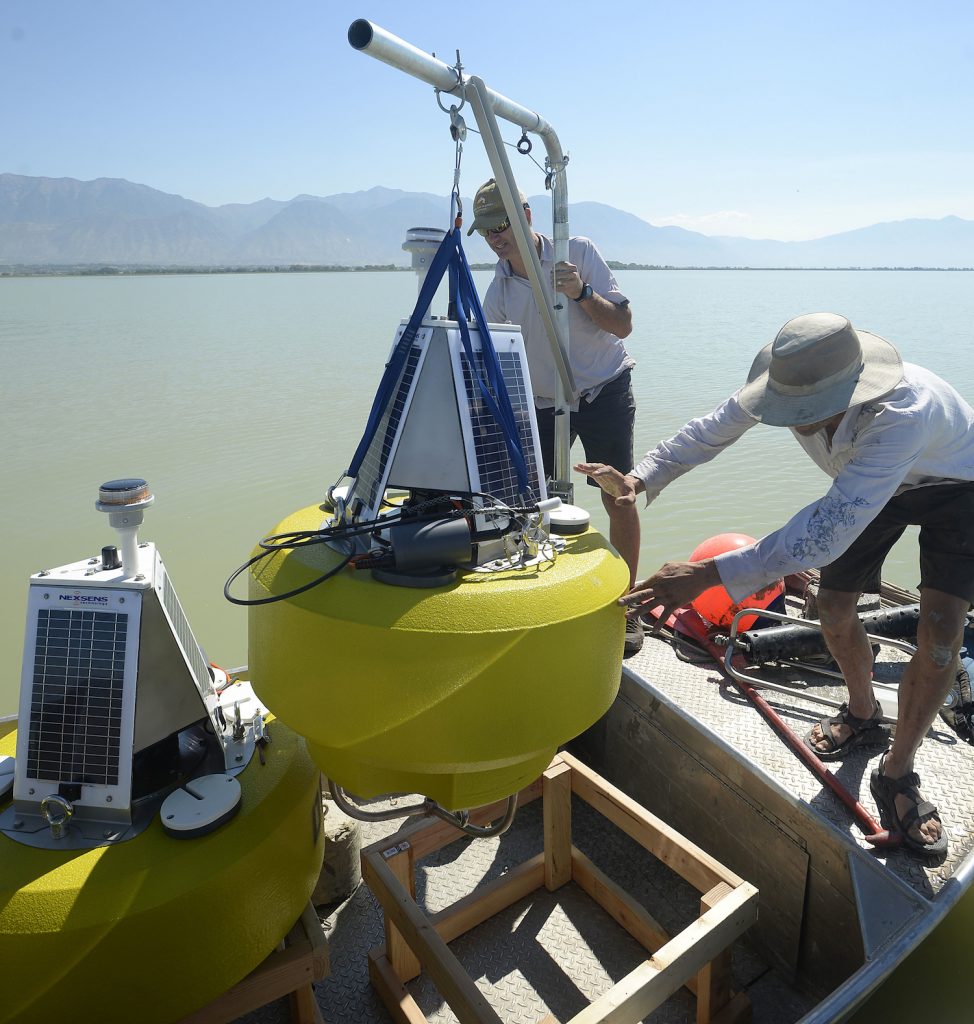
Environmental scientists Marshall Baillie, left, and Brent Shaw, with Utah Division of Water Quality, prepare one of three solar buoys housing probes for Utah Lake on Aug. 29.
Al Hartmann/The Salt Lake Tribune
Minutes into an excursion last week to dispatch new algae-tracking sensors into Utah Lake, one of the state's shallow-draft boats became mired at the outlet of the otherwise-desolate state park marina. As the Division of Water Quality crew worked to get the boat out into the water, they jokingly lamented their failure to bring an airboat.
Low water levels rendered boat access to Utah Lake almost impossible this year, said Eric Ellis, executive director of the Utah Lake Commission. Large signs at Utah Lake State Park declare the marina closed until next year; those boats that remain are now docked in the adjacent parking lot. That hasn't been good for recreation-oriented businesses on the lake, Ellis said, but the algae likely didn't mind.
"When water levels are low, it's easier for the lake to warm up" and foster algal blooms, Ellis said. "This year the lake was low much earlier than it has been in past years, so we saw an earlier bloom because the lake warmed faster."
As this summer's massive algal bloom on Utah Lake so eloquently demonstrated when it forced the closure of downstream irrigation companies in Salt Lake County, water supply can suffer when the quality of the water renders it unusable. But the inverse is true as well — inadequate water supply can concentrate pollutants, making water quality more difficult to maintain.
While a number of factors converged to help drain Utah Lake this summer, experts have begun to fault some of the state's water management policies, which they say fail to take the bigger picture into account.
Managing Utah waterways with an eye single to human needs like irrigation and sewage treatment, said Walt Baker, director of the Utah Division of Water Quality (DWQ), has "put us on a collision course for algal blooms to be the norm."
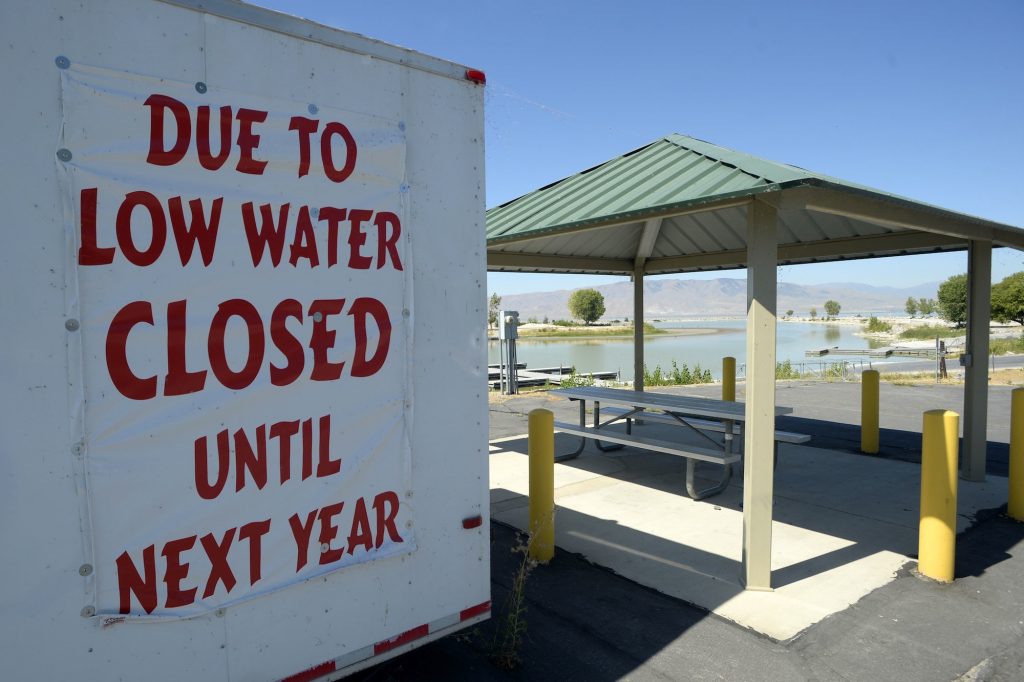
A sign at the marina boat harbor at Utah Lake State Park on Aug. 29.
Al Hartmann/The Salt Lake Tribune
Water demands
The DWQ has no authority to regulate water flow or allocation. That responsibility falls primarily to the Utah Division of Water Rights.
A water right, commonly referred to in Utah as "paper water," is a legal document that grants permission to withdraw a defined amount of water from a specific source. Water rights might be owned by a direct user, like a farmer, who uses the water to water crops. Or they might be held by municipalities or water companies, which then sell the water they withdraw to other users.
The Division of Water Rights stopped issuing new appropriations of water out of Utah Lake in the 1970s. That means the only way to obtain permission to take water out of Utah Lake now is to buy an existing water right from someone else.
"We had reached a point where the users in the basin were approaching what was naturally available," said Boyd Clayton, the division's deputy director.
Still, the terms of some historic agreements have allowed the actual amount of water diverted away from Utah Lake to gradually increase, Clayton said, even though the number of water rights has not changed.
For example, someone with a Weber River water right who returns his or her unused portion of that water to the drainage basin encompassing Utah Lake is entitled to an equal amount of water from the Utah Lake basin.
This rule has been on the books since about the 1920s, Clayton said, but recently, more water-rights holders have claimed what are known as return-flow credits, increasing the amount of water diverted away from Utah Lake.
There are also a number of water rights in Utah Lake that have been dormant but have come back into use, further increasing demand, Clayton said.
Downstream, some water users say a turn-of-the-century legal arrangement with Salt Lake City forces them to waste water they no longer want.
'Down the ditch'
When agriculture was the way of life along the Wasatch Front, Salt Lake-area irrigation companies held water rights to streams in Little Cottonwood, Big Cottonwood, Millcreek and Parleys canyons, and delivered the fresh mountain water to farmers.
But in the late 1800s, Salt Lake City's urban population was growing and in need of cleaner water. The irrigation companies, meanwhile, had discovered that the canyon streams could run low in the late summer, and wanted a more reliable source.
So a deal was struck, and some 50 of those irrigation companies agreed to turn over their canyon water rights to Salt Lake City, and in exchange, the city agreed to supply the companies with water from its own holdings, which include about 27,000 acre feet, or approximately 8.7 billion gallons per year, out of Utah Lake.
Big Ditch Irrigation Company once owned water rights in Big Cottonwood Canyon and served some 2,700 acres of farmland, according to its president, Paul Southam.
Today, the city delivers about 3 billion gallons annually from Utah Lake to the Big Ditch system, but his customers use only about 5 percent of it, he said. The company's down to about 30 acres of farms and is struggling to make ends meet.
He's tried to get out of the water business, he said, only to have the company's exchange arrangement with Salt Lake City get in the way.
Big Ditch has tried to sell its exchange agreement with Salt Lake City to other municipalities, which would obligate Salt Lake City to deliver water to someone else. The company has also suggested that Salt Lake City simply retire the agreement and give Big Ditch some of the city's water rights in Utah Lake, which the company could then sell at the going market rate for water rights.
But in response to each proposal, Southam said, Salt Lake City "calls up the water cartel to come beat down on our heads and basically threaten to sue us" in order to block the sale.
Salt Lake City has offered to buy out Big Ditch's unused interests in the exchange agreement, Southam said, but the price they've suggested is unsatisfactory. So Big Ditch Irrigation Company continues to take the city's water, Southam said, and "just sends it down the ditch."
Though irrigation companies now have far fewer farms to serve, it would be difficult to walk away from the agreements, said Laura Briefer, director of utilities for Salt Lake City, as most of the canyon water obtained by the city is now used for culinary purposes.
She said the city's standing policy has been to buy up customer's unwanted irrigation shares or even whole canal companies.
But as long as an irrigation company continue to operate, the city is legally bound to continue delivering water.
"We've worked with the canal companies to say, 'OK, what quantities do you need and want,' " Briefer said, "but we're still contractually required to meet these exchange agreements, and if we don't meet the terms, we risk our water rights in Big and Little Cottonwood canyons."
Though there have been reports of canals and ditches in Salt Lake City running high with unused irrigation water, Briefer said that to her knowledge all that water is headed to some downstream customer. The practice of refusing buyouts and accepting large quantities of water with no intention of delivering it to customers appears to be unique to Big Ditch, she said.
Fighting for their rights
Another flaw of the system, Baker said, is that in many cases, Utah hasn't taken the ecosystem's need for water into account.
Unlike many other states, Baker said, Utah has not established strong standards that require a minimum amount of water to be left in a lake or a river to preserve the aquatic ecosystem. There is a mechanism on the books that allows the Division of Utah State Parks and Recreation to secure water rights for the purpose of maintaining minimum water levels, but that rarely happens, and no other entity may purchase unused water rights for conservation purposes.
Leland Myers, manager of the Central Davis Sewer District, said he tried once to tweak the rule to obtain water rights to preserve local fisheries. That attempt, he said, was blocked by special interest groups.
Many water rights holders, the bulk of whom are farmers whose livelihood depends on the accessibility of water, fear water they may need one day will be taken from them in the name environmental interests. But Baker believes there may be a way to appease both groups.
In some states, he said, water-rights holders have the option to lease, rather than sell, their water rights to another party that essentially pays them to keep that water in the river. The person who holds the water right can use it if they need it, Baker said, but the water stays in the ecosystem most of the time.
There would be some long-term costs associated with the leases that would have to be paid by a governmental or nonprofit entity, Baker said, but this resolution might be more cost-effective in the long run than trying to clean up the leftover water that remains in Utah Lake.
This is why Myers, who helped develop the state's rule requiring wastewater treatment plants to reduce their discharge of phosphorus by 2020, is opposed to additional such regulations. If you get wastewater clean enough, he said, you open that water up for reuse.
And if that happens, he said, the state will be able to continue to grow its population for a longer period of time before it has to reconsider how water is distributed on the Wasatch Front.
"We need a holistic solution," he said, "and it needs to be economically viable, and some of that needs to be pushed into water rights, or we're going to suck the environment dry."
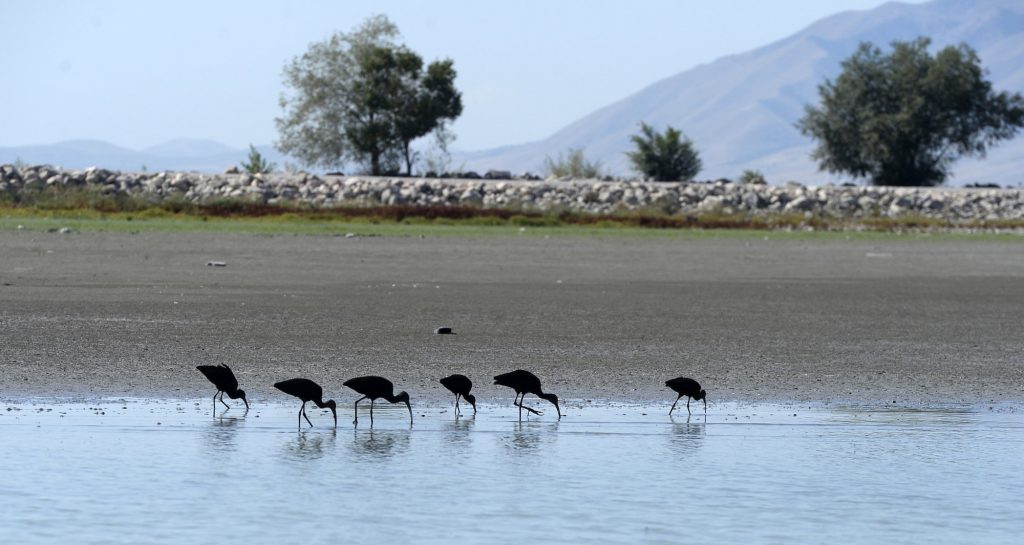
Ibis search for food on a newly uncovered sandbar in the marina boat harbor at Utah Lake State Park on Aug. 29.
Al Hartmann/The Salt Lake Tribune
Water all around
After this summer's events, Briefer said that she too has concluded that the state needs to approach water issues from a wider point of view.
While state officials and scientists were aware there was trouble brewing on Utah Lake, Salt Lake City was caught unaware when the bloom spread downstream and forced the city to find replacements for the water it pulls from Utah Lake.
"We'd had algal blooms on the lake before," Briefer said, "but we had never seen anything like this in the past, and hadn't anticipated that this kind of thing could occur, which to me painted a pretty strong picture in terms of the need for integrated resource management."
The current system, she said, has various state agencies looking at narrow issues — the Division of Water Rights deals with the legal aspects of who is entitled to what water, for example, while the Division of Water Quality is focused on what goes into the water.
Someone, she said, needs to take a step back and consider the overall situation.
"I do think people are doing their best to manage the frameworks they have," she said. "Now maybe we have an opportunity to manage things differently than we have, because now we've had a wakeup call."
And it's not just about the amount of phosphorus discharged into a lake, or the minimum amount of water required to be left flowing in a river, Briefer said. It's also about looking at how climate change could alter the nature of the local water system, or at how the condition of streambanks and other riparian areas impacts the overall system's health. The Wasatch Front, due to the interconnectedness of its waterways and the lessons taught by recent events, has the opportunity to sit down and talk about how all these factors determine the future of its waters, she said.
The challenge, she said, lies in whether Utah will be able to bring "a lot of diverse and valid opinions and perspectives to the table to ... work toward a common solution."
To view comments on this story or add your own, click here.
